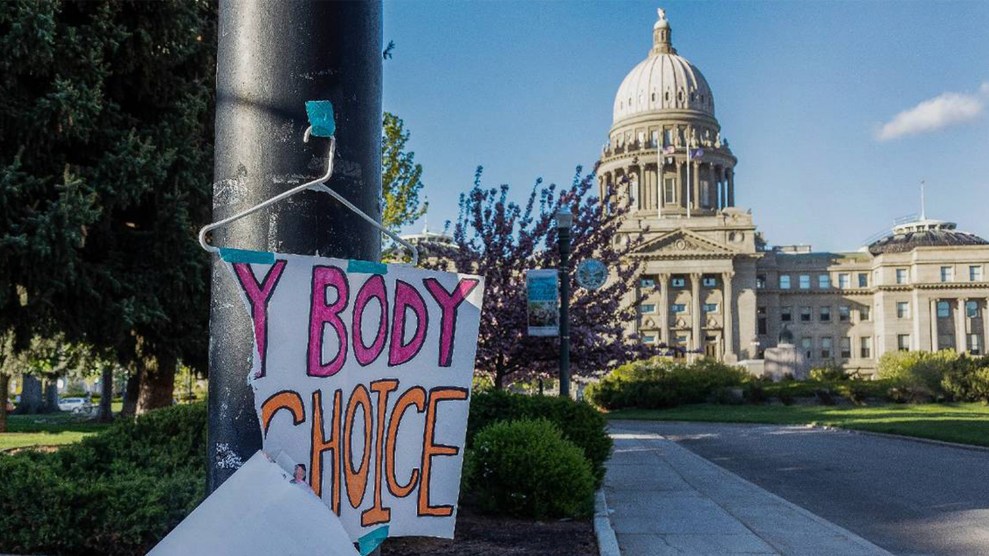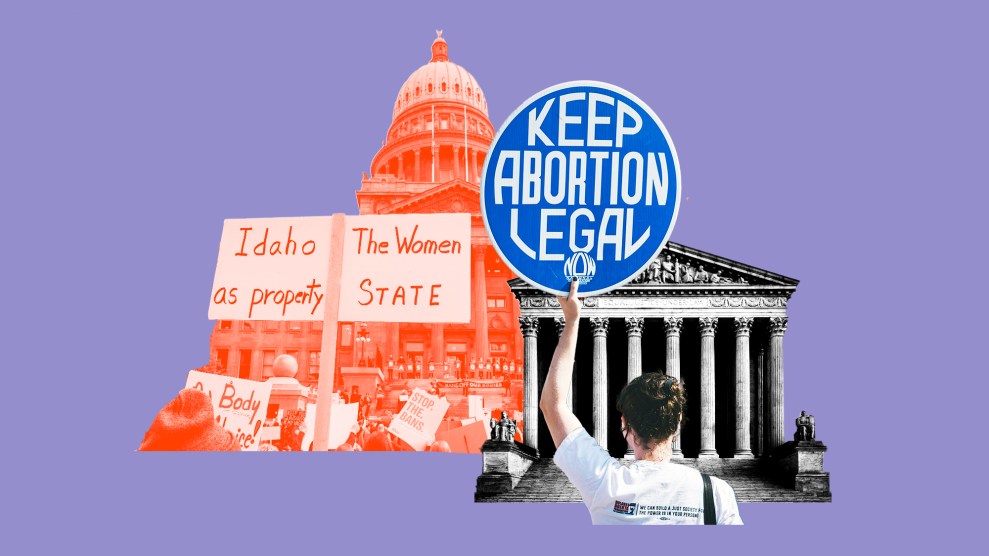
Sarah A. Miller/TNS via ZUMA
Update, June 27: The Supreme Court released its opinion in Moyle v. United States on Thursday after accidentally posting it to the court’s website on Wednesday. The final decision appears to be unchanged.
The Supreme Court is poised to issue a decision punting on one of the term’s most closely watched abortion cases.
The decision will leave for another day—one not just months before a presidential election—the question of whether pregnant people have the right to an abortion when it is the only treatment that will stabilize a medical emergency. It also pushes off deciding how to resolve conflicts between state and federal law over abortion.
“Today’s decision is not a victory for pregnant patients,” according to Justice Ketanji Brown Jackson.
While the decision in Moyle v. United States has not been formally issued, the Supreme Court briefly posted the document to its website Wednesday morning, according to Bloomberg News. The court acknowledged Wednesday that the opinion was “inadvertently and briefly uploaded” but did not confirm that the document was the final version. “The Court’s opinion in Moyle v. United States and Idaho v. United States will be issued in due course,” spokesperson Patricia McCabe said in a statement.
The unsigned opinion is the result of a 6-3 vote to allow emergency abortions to resume in Idaho, with Justices Samuel Alito, Clarence Thomas, and Neil Gorsuch dissenting. While the opinion will lift an order the court issued in January that blocked emergency abortions in Idaho during litigation, in writing separately, Justice Ketanji Brown Jackson warned that returning the case to the lower courts is not a win for abortion rights—but rather a delay that she did not agree with. “Today’s decision is not a victory for pregnant patients in Idaho,” Jackson wrote in the released document, concurring with the decision to reallow emergency abortions in Idaho but dissenting with the decision not to decide the merits of the case. “While this court dawdles and the country waits, pregnant people experiencing emergency medical conditions remain in a precarious position.”
The case goes back to about a month after the Supreme Court’s 2022 Dobbs v. Jackson Women’s Health Organization decision ending the right to an abortion, when one of the nation’s strictest bans went into effect in Idaho. Because it barred abortions unless one was needed to save the life of the mother, the Biden administration sued, arguing the state’s law conflicted with the Emergency Medical Treatment and Labor Act (EMTALA). That federal law requires hospitals to provide stabilizing treatment to anyone who needs it, or risk losing Medicare funding. In some cases, an abortion is the only treatment that will stabilize a pregnant patient facing dire health consequences—if not yet death.
Such situations generally occur when a fetus cannot survive and the end of the pregnancy is imminent. This includes cases when the water breaks before the fetus can survive outside the womb, and an abortion is required to prevent serious, even life-threatening, consequences for the mother. Yet hospitals in states with strict abortion bans have begun to turn these women away until they become very sick, leading to near-death experiences that can have serious consequences for the mothers’ health and future fertility.
Losing access to emergency abortions would prove fatal in some cases. As the American College of Obstetricians and Gynecologists warned in an amicus brief, “four in five pregnancy-related deaths nationwide are preventable. Deterring and delaying care to Idaho patients facing obstetrical emergencies will inevitably worsen those outcomes.”
When a state law conflicts with a federal law, federal law wins. In that sense, this case was an easy one. But when the justices allowed Idaho’s ban to fully take effect in January, it allowed state law to trump federal law. The result, in Idaho, was that providers had to regularly airlift women to other states for emergency abortion care. “This months-long catastrophe was completely unnecessary,” Jackson wrote. “More to the point, it directly violated federal law, which in our system of government is supreme.”
Even though the released decision would let federal law reign once again in Idaho, Jackson points out that the court’s decision not to decide the case on the merits leaves Americans across the country in the same limbo. “The United States is still hamstrung in its ability to enforce federal law while states pass laws that effectively nullify EMTALA’s requirements,” Jackson’s concurrence continues. As a result, patients suffer as doctors and hospitals delay care.
By refusing to decide the merits of the case, the court’s ruling will create a patchwork of enforcement throughout the country. The Fifth Circuit Court of Appeals held in January that EMTALA cannot force states to allow emergency abortions, so the high court’s failure to act would mean that pregnant people living in that circuit—Texas, Louisiana, and Alabama—lack EMTALA’s protections, even as they are returned, at least for now, to Idahoans. “Given the populations” of Texas compared to Idaho, “that’s not a win,” wrote Greer Donley, an abortion law expert at the University of Pittsburgh School of Law. “The Supreme Court’s punt on the emergency abortion case (assuming it’s real) is not even a short-term victory,” she adds. “It’s a short-term mixed bag where many more women are suck in states without health exceptions (only life exceptions, which are failing).”
Sending the case back allows the justices to avoid an abortion decision in an election year.
What’s more, draconian abortion bans are affecting emergency abortion access in states where abortion bans technically provide health exceptions when the life of the mother is not in danger, but where fear of prosecution has nonetheless pushed hospitals to delay care.
“I worry that this will be reported as a big win for abortion rights,” Mary Ziegler, a law professor at UC Davis and a leading abortion historian, noted on X. “The litigation will continue if this is the final decision. The theme of both [abortion] cases this Term is that SCOTUS is kicking the can down the road—and significantly, until after a major election.”
Indeed, sending the case back to the lower courts allows the justices to avoid handing down a potentially unpopular abortion decision in a presidential election year—one in which the court’s unpopular Dobbs decision, and broader Republican support for abortion bans, threaten GOP candidates up and down the ballot. A decision removing the right to emergency abortion care would have once again put the court and abortion rights at the center of the political debate. Maybe that’s what Chief Justice John Roberts and Justices Brett Kavanaugh and Amy Coney Barrett sought to avoid in constructing a majority alongside two Democratic-appointed justices. As Jackson wrote, the court was trying to get out of a tough situation by alleging that it had used a procedural tool to “avoid issues that it does not wish to decide.”
Those three conservative justices argue that both Idaho and the United States altered their positions substantially during litigation—enough to require the case to be sent back. During oral argument, Barrett wrote in a concurrence joined by Roberts and Kavanaugh, the solicitor general had acknowledged limits to EMTALA, and that Idaho’s attorney had, at times, portrayed the state’s law as less extreme than how it is written.
In the released dissent, written by Justice Alito and joined by Thomas and Gorsuch, the minority argues Idaho should have prevailed. In their view, EMTALA does not protect emergency abortion care because the statute does not explicitly mention abortion as a required treatment. (In fact, the law does not spell out any specific procedures.) And they question, along with the other three GOP-appointees, whether the federal government can preempt state criminal laws by threatening to withhold federal funds.
Idaho’s abortion ban had created a maternal care crisis in the state even before the Supreme Court halted emergency abortion care there. The same thing is true in other states with strict abortion bans; the healthcare crisis Dobbs created is a nationwide emergency. By punting, the court puts off for another day a decision that could render out-of-state airlifts of women whose pregnancies have become too dangerous a common feature of American medicine.
Jackson’s concurrence is a stark warning that the right to a medically-necessary emergency abortion remains imperiled. “Storm clouds loom ahead,” she wrote. “Three justices suggest, at least in this context, that states have free rein to nullify federal law. And three more decline to disagree with those dissenters.”
We can all do that math.
















